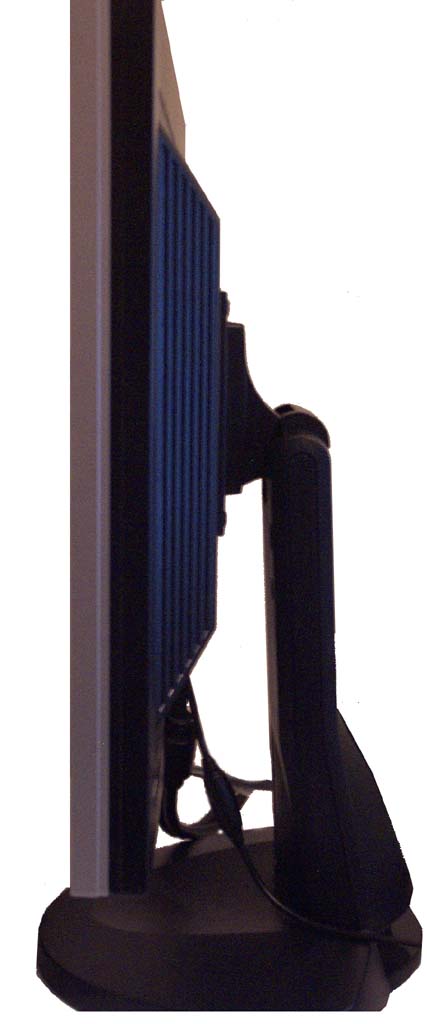Construction
The Samsung 191t shines brilliantly in its construction. The LCD TFT display is of Samsung design and manufacture, as we would expect from a big name. The screen itself appears to be of excellent quality; there are no defects in the pixels, and no warping on the surface. It is perfectly flat.

LCD monitors have traditionally been very expensive because of the production process. This is simply because of the sheer numbers of flaws in each batch of monitors. As true with almost any electronic product, enormous amounts of materials are wasted when the final products are defective. Most LCD monitors operate on Active Matrix displays (including the 191t).
Active Matrix display simply means for each pixel on the screen, there are three subpixels within it. One for Red, one for Blue, and another for Green. Each of these subpixels contains one transistor. For a monitor that supports a resolution of 1280 x 1024, there must be a total of 3,932,160 transistors. Anyone who has bought an LCD monitor before knows if even just one pixel is defective an annoying white spot might show up in the middle of the screen. Quite often, buying a knockoff monitor on EBay will be riddled with these spots.
Because Samsung is a leader in the LCD industry, its quality control is one of the most mature on the market. Obviously, you pay a little more for this type of quality control. However in the long run you will be thanking yourself for doing so. Try as hard as we could, there were no noticeable defects in this monitor. Granted, this was a monitor Samsung hand picked and shipped to us via private courier to review. Naturally, we stopped over to the nearest large but nameless computer/electronics store to compare a boxed model 191T and ours. With only minimal confrontation we were able to convince the 16-year-old (who we shall call “Jim”) sales representative to open and turn on a boxed 191T. We only had about 15 minutes or so before “Jim” realized we weren’t actually going to buy this monitor. Nevertheless, the quality of the boxed monitor and the review monitor were fairly close. We did not see any defects or broken pixels.
The 19” LCD screen produces a true 19” diagonal viewing space. When placed next to last week’s Cornerstone C1035, the similarities in viewable area were fairly striking (the C1035 has a viewing area around 19.5”). Unfortunately though, it is an LCD monitor, and the maximum resolution is only 1280x1024. While rapidly maturing, the manufacturing process still has not reached the point where larger resolutions can be produced without massive defects (consistently anyway). The supported refresh rate of 76Hz on the Analog input and 60Hz on the Digital input were fairly pleasing to the eye. Even though CRT monitors produce a much high refresh rate at this resolution, they cannot remotely replicate the sharpness. We did not notice any flicker at 1280x1024.

The footprint on the 191t was incredibly small. The product spec sheet claims the WxHxD dimensions are 16.4" x 17.7" x 8.2.” However the depth is actually much less than that. We found only when the monitor is tilted back all the way such a depth be achieved. Incredibly, this monitor only weighs 13lbs. The feature that gives the 191t the most distinction is its incredibly small trim around the LCD. At 18.6mm, this monitor gives an incredibly sleek feeling. This trim (called the bezel) is currently the slimmest on the market, and it definately delivers a certain "Wow."
Below is a summary of the Samsung 191T’s specifications:
| Samsung SyncMaster 191T |
|
|
|
|
| LCD |
19”
A-Si TFT LCD (Active Matrix) |
| Scanning Frequency |
Horizontal:
30-81kHz |
| Response Time |
Under 25ms |
| Compatibility |
1280 x 1024 Native |
| Dimensions (WxHxD) |
16.4" x 17.7" x 8.2" |
| Power |
Working : 40W Max Standby/Off: 3W |
| Dimensions (WxHxD) |
16.4" x 17.7" x 8.2" |
| Weight |
13 lbs |
| Warranty |
3
years parts and labor |











1 Comments
View All Comments
Anonymous User - Monday, October 27, 2003 - link
Good review but reviewer doesn't seem to realize that power consumption and heat dissipation are one and the same (ie every Watt that goes into the monitor is converted to one Watt of heat).